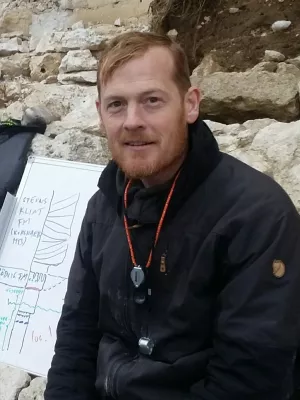
Mikael Calner
Professor

Palaeokarst evidence for widespread regression and subaerial exposure in the middle Katian (Upper Ordovician) of Baltoscandia: significance for global climate.
Author
Summary, in English
We report on widespread and contemporary palaeokarst in the middle Katian (Upper Ordovician) of Sweden,
Estonia and Latvia, the first major palaeokarst horizon to be reported from the Ordovician of Baltoscandia. The
solution features occurwithin a fewmetres of thick zone of limestone immediately belowthe widespread Fjäcka
Shale and are related to an unconformity with preserved palaeorelief in the Slandrom Limestone in Sweden and
the time-equivalent Saunja Formation in Estonia and Latvia. Facies evidence for a karst origin comes fromseveral
outcrops and core sections and includes 1) frequent karren-likemorphologies interpreted as ‘Swiss-cheese’ karst
[sensu Baceta et al., 2001], 2) local occurrences of solution/collapse breccia, 3) presence of bladed pseudospar
crystals in solution cavities, and 4) carbon isotope values indicating meteoric influence to the succession. These
findings are herein put in context with previously reported, large-scale erosional channels that may cut down
several tens of metres below the Fjäcka Shale in the subsurface Baltic Sea area, and with regional, anomalous
thickness variations in the Slandrom Limestone and Saunja Formation, all together forming strong support for
regional exposure of the Baltoscandian continent in the middle Katian. High-resolution stable isotopic data show
that the regression and lowstand of sea-level overlap with theWaynesville carbon isotope excursion. It resulted
in basin-wide cessation of carbonate production near the Amorphognathus superbus and A. ordovicicus conodont
zonal boundary. The contemporary development of palaeokarst in different confacies belts of the basin suggests
that this was an extraordinary sea-level lowstand, herein interpreted as reflecting a middle Katian glaciation.
Estonia and Latvia, the first major palaeokarst horizon to be reported from the Ordovician of Baltoscandia. The
solution features occurwithin a fewmetres of thick zone of limestone immediately belowthe widespread Fjäcka
Shale and are related to an unconformity with preserved palaeorelief in the Slandrom Limestone in Sweden and
the time-equivalent Saunja Formation in Estonia and Latvia. Facies evidence for a karst origin comes fromseveral
outcrops and core sections and includes 1) frequent karren-likemorphologies interpreted as ‘Swiss-cheese’ karst
[sensu Baceta et al., 2001], 2) local occurrences of solution/collapse breccia, 3) presence of bladed pseudospar
crystals in solution cavities, and 4) carbon isotope values indicating meteoric influence to the succession. These
findings are herein put in context with previously reported, large-scale erosional channels that may cut down
several tens of metres below the Fjäcka Shale in the subsurface Baltic Sea area, and with regional, anomalous
thickness variations in the Slandrom Limestone and Saunja Formation, all together forming strong support for
regional exposure of the Baltoscandian continent in the middle Katian. High-resolution stable isotopic data show
that the regression and lowstand of sea-level overlap with theWaynesville carbon isotope excursion. It resulted
in basin-wide cessation of carbonate production near the Amorphognathus superbus and A. ordovicicus conodont
zonal boundary. The contemporary development of palaeokarst in different confacies belts of the basin suggests
that this was an extraordinary sea-level lowstand, herein interpreted as reflecting a middle Katian glaciation.
Department/s
- Lithosphere and Biosphere Science
Publishing year
2010
Language
English
Pages
235-247
Publication/Series
Palaeogeography, Palaeoclimatology, Palaeoecology
Volume
296
Issue
3-4
Document type
Journal article
Publisher
Elsevier
Topic
- Geology
Status
Published
ISBN/ISSN/Other
- ISSN: 1872-616X

